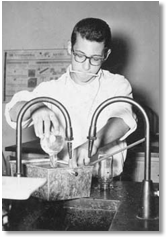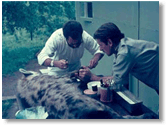Dr. Joel Wallach

Dr. Joel D. Wallach is a veterinarian, naturopathic physician, author and lecturer who played a major role in the development of the market of liquid vitamin – mineral supplements. He became nationally known through his widely distributed audio tape, “Dead Doctors Don’t Lie”. Periodically, critics question his background and some of his views. The present account specifically analyzes some of the objections raised in the Third Edition of the Medical Resource Manual (First Image, Inc.), 1997 pp. 74-75.
Joel D. Wallach was born in West St. Louis County on June 4, 1940. Growing up on a farm led him to decide already early in his life to become a veterinarian and nutritionist. After finishing high school, Wallach enrolled in the University of Missouri at Columbia, first to study Agriculture with a major in animal husbandry and a minor in field crops and soils. The School of Agriculture at the University of Missouri has departments of nutrition, food science, geology and biochemistry and an internationally acclaimed “Trace Substances Research Center” which explores the biological, economic, and health significance of trace substances in environmental health. In this interdisciplinary academic environment, Wallach flourished and gathered a wealth of information that would later help him in his practice as a veterinary pathologist and naturopathic physician. In 1962, Wallach received a B.S. Degree in Agriculture from Missouri and continued on to study veterinary medicine at the same Institution, which in 1964 awarded him the degree of Doctor of Veterinary Medicine (D.V.M.). From 1966 to 1967, he held a post-doctoral fellowship in comparative medicine at the Center for the Biology of Natural Systems, George-Washington-University, St. Louis. Thereafter, Wallach worked at Iowa State University Diagnostic Laboratory, Ames, Iowa, and subsequently, for two years, at Natal Fish & Game Department, Natal, Republic of South Africa.
Dr. Joel D. Wallach’s background and professional career
Dr. Joel D. Wallach is a veterinarian, naturopathic physician, author and lecturer who played a major role in the development of the market of liquid vitamin – mineral supplements. He became nationally known through his widely distributed audio tape, “Dead Doctors Don’t Lie”. Periodically, critics question his background and some of his views. The present account specifically analyzes some of the objections raised in the Third Edition of the Medical Resource Manual (First Image, Inc.), 1997 pp. 74-75.
Joel D. Wallach was born in West St. Louis County on June 4, 1940. Growing up on a farm led him to decide already early in his life to become a veterinarian and nutritionist. After finishing high school, Wallach enrolled in the University of Missouri at Columbia, first to study Agriculture with a major in animal husbandry and a minor in field crops and soils. The School of Agriculture at the University of Missouri has departments of nutrition, food science, geology and biochemistry and an internationally acclaimed “Trace Substances Research Center” which explores the biological, economic, and health significance of trace substances in environmental health. In this interdisciplinary academic environment, Wallach flourished and gathered a wealth of information that would later help him in his practice as a veterinary pathologist and naturopathic physician. In 1962, Wallach received a B.S. Degree in Agriculture from Missouri and continued on to study veterinary medicine at the same Institution, which in 1964 awarded him the degree of Doctor of Veterinary Medicine (D.V.M.). From 1966 to 1967, he held a post-doctoral fellowship in comparative medicine at the Center for the Biology of Natural Systems, George-Washington-University, St. Louis. Thereafter, Wallach worked at Iowa State University Diagnostic Laboratory, Ames, Iowa, and subsequently, for two years, at Natal Fish & Game Department, Natal, Republic of South Africa.

Dr. Joel Wallach’s publications and number of autopsies performed

A partial list of Dr. Wallach’s publications, reviews and books authored or coauthored during the period from 1965 to 1994 comprises 55 titles; 20 of his papers were published in the Journal of the American Veterinary Medical Association (JAVMA); 6 reviews appeared in professional books, the remainder in other professional veterinary journals.
Wallach furthermore is the coauthor (with W.J. Boever) of an authoritative treatise, “Diseases of Exotic Animals: Medical and Surgical Management” published by W.B.Saunders Co. Philadelphia in 1983. He also authored (with Ma Lan) two books directed to lay audiences, “Let’s Play Doctor” and “Rare Earth’s and Forbidden Cures”, both published by Double Happiness Publishing Co., Bonita, CA. His first paper appearing in 1965 describes goitrogenic hypothyroidism in feeder lambs; subsequent articles and reviews deal, inter alia, with common diseases and treatments for waterfowl, game birds, exotic birds, reptiles, fish, ruminants, kangaroos, monkeys, elephants, nutritional problems of captive exotic animals, descriptions of a case of degenerative arthritis in a black rhinoceros, of visceral gout and nutritional problems in captive reptiles, angioedema in a gorilla, fibrous osteodystrophy and hypervitaminosis D in green iguanas, the immobilization of small and very large animals (rabbits, Guinea pigs, African elephants), steatitis in captive crocodiles, the anaesthesia of reptiles, the hand-rearing of a white rhinoceros, surgical techniques for caged birds, the management of captive elephants, erysipelas and cystic fibrosis. His papers and reviews are well written, thoroughly referenced and often richly illustrated. Exemplary is his review “Nutritional Diseases of Exotic Animals” appearing in 1970 (JAVMA 157, pp. 583-599) in which he documents numerous diseases in a wide variety of captive exotic animals resulting from improper feeding practices. In this review, Wallach presents 19 photographs of animals or organs of animals with nutritional diseases, all of which are from his own work files. A review on environmental nutritional diseases of captive reptiles appearing in 1971 JAVMA 159, pp. 1632 – 1643 shows 18 photographs of reptilians or organs thereof, 17 of which are his. Another review appearing in the same year on management and medical care of goldfish (JAVMA 159, pp. 583 – 595) describes everything a veterinary doctor needs to know on this topic. It discusses breeding and pediatrics, biological data, nutritional and metabolic diseases, infectious diseases, parasites, skin diseases, diseases of the circulatory, respiratory, digestive and nervous systems, diseases of the genitourinary tract, infectious diseases as well as methods of surgery and anesthesia. In a 1977 paper (with M.S.Silberman), JAVMA 171, pp. 906 – 907, Wallach describes the foot care of captive elephants. These few examples should suffice to reveal his professional versatility and expertise. Wallach had access to many species of animals, large and small, and received autopsy material from zoos all over the Country. That explains the very large number of autopsies which he claims to have performed, a total of 17,500 of 454 animal species, and 3000 of humans, over the period of 12 years. That number is not excessive for a fully employed veterinary pathologist, because it on average amounts only to about 7 autopsies per day, assuming 250 working days per year, and taking into account that many of the autopsies involved small animals and were routine.